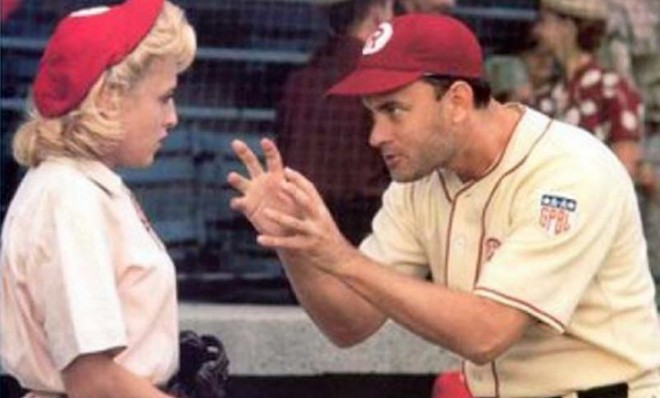The 25 films added to the National Film Registry in 2012
The annual selections by the Library of Congress span more than a century of American filmmaking


Every year since 1989, the Library of Congress has selected 25 films to preserve in the National Film Registry, a 600-film (and counting) collection of some of America's most important achievements in filmmaking. The movies, according to Librarian of Congress James M. Billington, are not necessarily "the best American films of all time," but the films that are "culturally, historically, or aesthetically significant" to the American people. This year's eclectic crop spans more than a century of filmmaking, from a taped boxing match to a film that revolutionized American action cinema. Which 25 films made the cut in 2012, and why? A guide:
1. The Corbett-Fitzsimmons title fight (1897)
A 100-minute film that captured all 14 rounds of a championship boxing match. It was the longest film of its era, and it generated $750,000 over the several years that it remained in distribution.
The Week
Escape your echo chamber. Get the facts behind the news, plus analysis from multiple perspectives.

Sign up for The Week's Free Newsletters
From our morning news briefing to a weekly Good News Newsletter, get the best of The Week delivered directly to your inbox.
From our morning news briefing to a weekly Good News Newsletter, get the best of The Week delivered directly to your inbox.
2. Uncle Tom's Cabin (1914)
Harriet Beecher Stowe's legendary anti-slavery novel was published in 1852, and was frequently adapted in the early days of American film — but until this version, the character of Uncle Tom was always played by a white actor. The 1914 film, with vaudevillian Sam Lucas in the title role, is thought to be the first feature-length American film to star a black actor.
3. The Wishing Ring: An Idyll of Old England (1914)
This light-hearted silent romance was thought lost for decades until film historian Kevin Brownlow discovered a print of the film in Northern England. Since its discovery, silent film experts have deemed it an early cinematic masterpiece, praising its use of camera work, lighting, and editing.
A free daily email with the biggest news stories of the day – and the best features from TheWeek.com
4. Kodachrome Color Motion Picture Tests (1922)
The first publicly demonstrated color film designed to attract the attention of the film industry. Prior to the introduction of Kodachrome and Technicolor film stocks, movies could only be made into color by hand-painting each frame or using a complex process involving mechanically produced stencils.
5. Sons of the Desert (1933)
A classic from Stan Laurel and Oliver Hardy sees the men facing a series of hilarious setbacks after they sneak away from their wives to attend a fraternal lodge convention.
6. The Middleton Family at the New York World's Fair (1939)
An industrial film that follows a family of five as they look to the future by attending the New York World's Fair. The movie also offers a moralistic message as the daughter turns on her anti-capitalist boyfriend in favor of an industrious engineer who works at the fair.
7. The Kidnappers Foil (1930s-1950s)
The product of a clever business started by Melton Barker, who intuited that people would want to see themselves on film. Barker traveled across the United States, assembling groups of children, charging their families for "acting lessons," and then having the children stage a short, melodramatic story about a kidnapped girl and the children who rescue her. The resulting film would then be screened for the town.
8. The Augustas (1930s-1950s)
Traveling salesman and Amateur Cinema League member Scott Nixon documents 38 streets, storefronts, and cities named Augusta, which he encountered on his travels over several decades.
9. Born Yesterday (1950)
Judy Holliday won the Academy Award for Best Actress for this film, a comedic satire on corruption in Washington, D.C., that may still resonate with audiences.
10. 3:10 to Yuma (1957)
A western classic based on a short story by Elmore Leonard, 3:10 to Yuma chronicles a rancher's attempt to deliver a criminal to a jail in Yuma, Arizona. A remake starring Christian Bale and Russell Crowe was released in 2007.
11. Anatomy of a Murder (1959)
This Jimmy Stewart-starring courtroom classic was enormously controversial for its frank discussion of rape and murder, which were largely considered taboo subjects in American film at the time.
12. Breakfast at Tiffany's (1961)
Truman Capote, who wrote the novella that Breakfast at Tiffany's was based upon, was reportedly unhappy with the film — he thought Marilyn Monroe should have the lead role — but the film remains a beloved American classic, noted for Audrey Hepburn's iconic performance as Manhattan socialite Holy Golightly.
13. Parable (1964)
An enormously controversial film that debuted at the New York World's Fair in 1964, Parable depicts Jesus Christ as a circus clown who takes on the suffering of oppressed workers, women, and minorities. Though the fair's president personally attempted to have it withdrawn, he was outvoted by attendees, and it became one of the fair's most popular attractions.
14. They Call it Pro Football (1967)
When NFL commissioner Pete Rozelle agreed to form NFL Films to drum up public interest in the game, his goal was to capture the "struggle" of football. This groundbreaking film, which used techniques like close-ups on players' faces and microphones to capture the evolving strategies of players and coaches, offered Americans far more insight into professional football than they'd ever had before.
15. Two-Lane Blacktop (1971)
A minimalist classic about a cross-country road race, financed by Hollywood as a part of the first wave of the American booming class of young filmmakers.
16. Dirty Harry (1971)
"Do you feel lucky?" In this early peak at Clint Eastwood's acting career, he plays San Francisco cop Harry Callahan, who's trying to catch a sadistic killer who calls himself Scorpio. More than 40 years after its release, Dirty Harry remains controversial for what some have derided as its "fascistic" philosophy, which sees Harry circumvent the law to catch Scorpio.
17. The Spook Who Sat by the Door (1973)
An extremely controversial film based on a bestselling novel by Sam Greenlee, The Spook Who Sat by the Door centers on a black man hired to integrate the CIA who uses his position to spark a black nationalist revolution in America. Though the film was financially successful, distributor United Artists pulled it after just three weeks after its release.
18. Hours for Jerome: Parts 1 and 2 (1980-1982)
An artistic "tone poem" by filmmaker Nathaniel Dorsky, who offers a loose record of a year with his partner, with Part 1 focused on spring and summer, and Part 2 focused on fall and winter.
19. A Christmas Story (1983)
A beloved comedy that continues to get extensive play every holiday season, A Christmas Story, which is based on the works of humorist Jean Shepherd, chronicles a young boy's desperate attempt to convince his parents to buy him a Red Ryder BB gun for Christmas in 1940s Indiana.
20. The Times of Harvey Milk (1984)
This winner of the Academy Award for Best Documentary tells the life story of Harvey Milk, San Francisco's first openly gay elected official, who was assassinated in 1978.
21. Samsara: Death and Rebirth in Cambodia (1990)
Originally filmed as the master's thesis of Stanford University's Ellen Bruno, Samsara chronicles Cambodia's struggle to rebuild its culture in the years following Pol Pot's killing fields.
22. Slacker (1991)
An early classic in the American independent cinema movement of the early 1990s, Richard Linklater's quirky snapshot of life in Austin, Texas, which he filmed for just $23,000, earned more than $1 million at the box office and inspired an entire generation of young filmmakers.
23. A League of Their Own (1992)
This star-studded dramedy centers on the All-American Girls Professional Baseball League, which sprung up during World War II, capturing a bygone era in American sports and offering insight into one early signifier of the American feminist movement.
24. One Survivor Remembers (1995)
An Academy Award-winning short documentary that recounts the experiences of Holocaust survivor Gerda Wiessmann Klein, a Polish Jew whose entire family was sent to a concentration camp when she was 16. She was the only member of her family to survive.
25. The Matrix (1999)
Andy and Lana Wachowski's mind-bending sci-fi action thriller set a new standard in the action genre. Keanu Reeves stars as Neo, the savior of the human race in a war against machines, in this film that launched a thousand "bullet time" parodies.
Scott Meslow is the entertainment editor for TheWeek.com. He has written about film and television at publications including The Atlantic, POLITICO Magazine, and Vulture.


